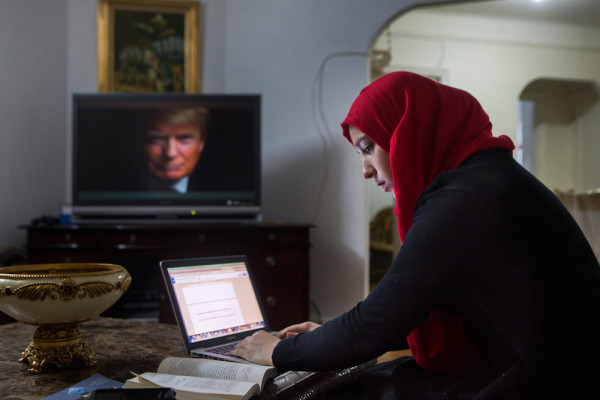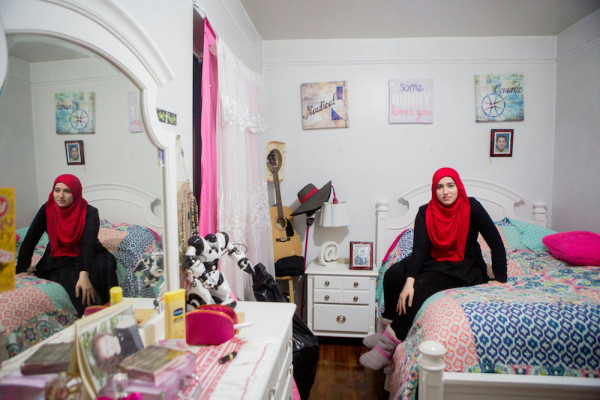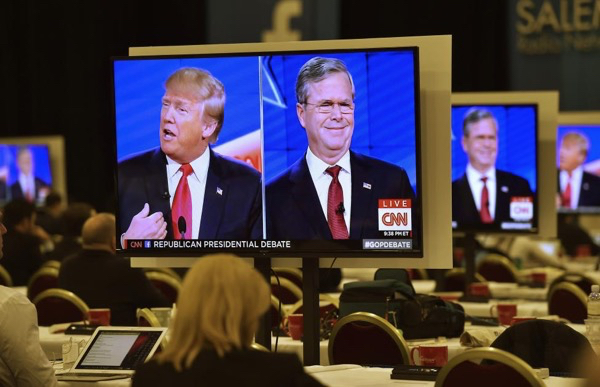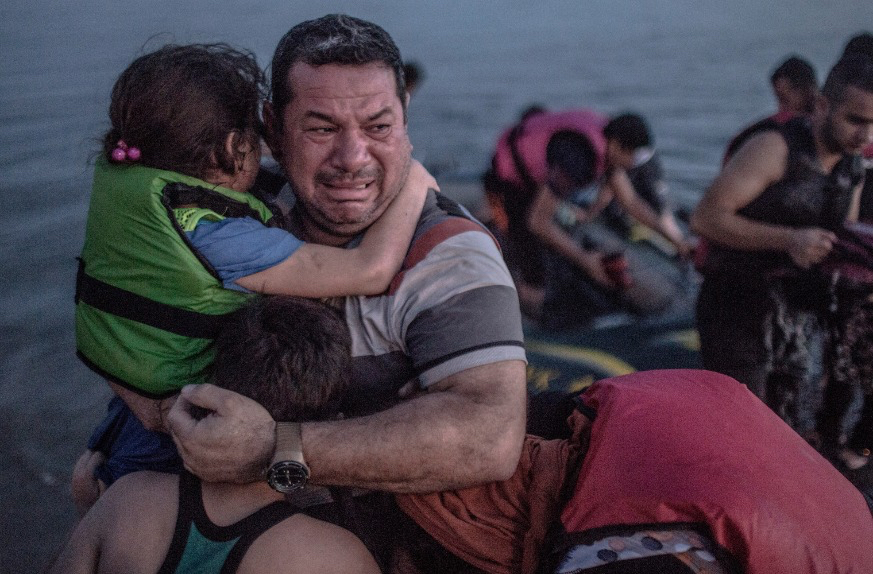Notes
On that Perfectly Real Photo of “Trump and the Muslim Girl”
“It was perfect.”
So said Michele McNally, ranking photo editor for the New York Times, regarding the above photograph that accompanied the paper’s December 14th article about young Muslim Americans who are experiencing anti-Muslim hostility in a post-9/11 world. The photo’s caption tells us: “Hebh Jamal, 15, studies at her family’s home in the Bronx.”
The photo resonated with NYT readers to such an extent that they asked if it had been staged. “It looks too good to be true,” McNally acknowledged, “but it isn’t.”
The photo also caught my eye because I’ve been thinking about how saturated the media is with pro-Trump visuals. Even as they call out the candidate for his countless incendiary statements, the media haven’t really shown us many visual fragments that align with his nasty written or spoken words (although this photo would certainly trouble that claim).
I recently read about the onset of a visual backlash of Trump imagery and media footage. I immediately thought of Johari Osayi Idusuyi, the woman who read Claudia Rankine’s Citizen during a Trump rally in November. It was a more subtle form of backlash – one that appeared pro-Trump on the surface yet performed the opposite when you peeled back the visual layers.
I see that same work being performed with this NYT photo, as it perfectly disrupts the current visual culture of Campaign 2016 and subverts Trump’s stance on Muslims in a manner that is subtle, yet spot-on. Put differently: this photo trolls Trump.
But how? Like the Idusuyi/Citizen photo, it’s about layers. At first glance, it invites us to see Trump through a lens of paternalism, almost as if he’s commander-in-chief watching over (and looking into) the homes of those he deems “suspicious” to ensure they’re under control. Hebh Jamal is being a good Muslim American by avoiding eye contact and keeping her head down. Trump’s surveillance keeps her in place – in the home, where she is not a threat to anyone. Indeed, his supporters might interpret this picture as an affirmation of Trump’s power and capacity to “make America great again.”
But that’s too obvious. The brilliance of this image lies in its subversion of Trump’s public stance on Muslims.
Hebh Jamal is a part that represents a whole – she embodies an entire community that Trump fears and has incited others to fear. Yet look at how perfectly this photo lays bare the ridiculous nature of that fear. Jamal is a student in the U.S. Jamal applies herself to a text as she works on a document on her Macbook Pro. Jamal is working at a table in her family’s home – a home that, from this vantage point, has all of the trappings associated with middle-class American life. Your every-teenager, Jamal keeps her smartphone close by. What are we meant to fear here?
Commonplace items also populate the second photo in the NYT article. Sitting on her pastel-colored quilted bed, those articles communicate her age and innocence: a playful hat, a guitar, family photographs, an ampersand ornament, a canvas reading “some BUNNY loves you.” A robot even sits on her dresser next to a mirror that reflects Jamal’s relaxed, yet somewhat cautious posture as she looks at the camera. What are we meant to fear here?
Nothing. And that is the point. These photos undermine Trump’s logic at the same time that they elevate domestic (Muslim) American life. The mirror photo offers a double image of Jamal – two perspectives of the same subject. Trump asserts that some Muslim Americans are leading double lives and are not really who they appear to be. But that argument, seen staring back at him through the mirror, is just an illusion. Trump’s gaze from the TV screen makes it look like he’s in control, but the joke’s on him and he doesn’t even realize it. He got (visually) trolled.
If we truly are on the verge of witnessing a visual backlash, I hope that we are exposed to more images like these – images that reject the xenophobic, racist, misogynist, ableist discourse spewed from the mouths of presidential hopefuls by reaffirming what American citizenship looks like.
McNally is right. This photo is perfect.
–Katie Irwin
(photos: Sam Hodgson for The New York Times. caption 1: Hebh Jamal, 15, studies at her family’s home in the Bronx. With the violent spread of the Islamic State and a surge in Islamophobia, she has had to confront the harsh challenges of being a young Muslim in America. caption 2: Ms. Jamal in her bedroom. “I feel like the past two months have probably been the hardest of my life,” she said of the recent rise in anti-Muslim sentiment.)




Reactions
Comments Powered by Disqus